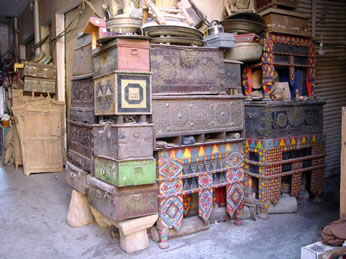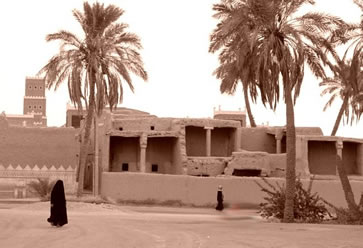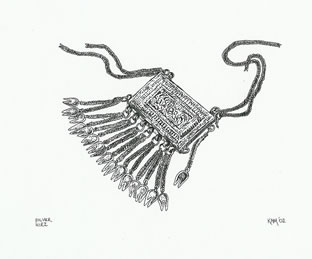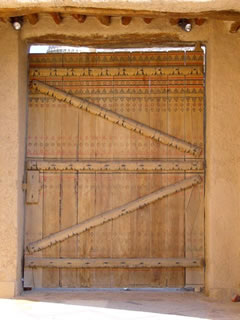(Stories of Daily Life in Saudi Arabia)
by Unda DeVeil
A short introduction. Stories of every day life in Saudi Arabia, as seen through the eyes of a British woman living there, may interest some of you. I hope so, as it is my intention to write something witty and amusing as well as to give an idea of daily life in a totally different culture and lifestyle.
So, what exactly do you find to do all day? A continuation of Week
in the life day four. 
Tuesday. Excitement!! I have received some post this morning - a small
clothing catalogue from a USA company, a holiday brochure from London
and a letter and music CD from a friend in UK. As usual the envelopes
have all been torn open for examination at customs and badly stuck together
again afterwards, leaving the recipient unsure whether originally the
envelope didn‚t hold double the contents. However, the holiday
brochure appears to be fully intact, though every female in a swimsuit
is now in a lovely black neck-to-ankle costume. The clothing catalogue
still has most of its pages (without even looking I know the underwear
and swimwear pages will be missing). And the CD is still in its case,
though I've no idea what was on the front cover, as it is now mostly
black. Yes, the Representatives for the Office for the Promotion of
Virtue and Prevention of Vice have had their black marker pens busy
at work again, but at least my mail has arrived.
This morning I'm going to the souk, which is in the old part of the
city. As most of it is outdoors it is hot and dusty, but worth the discomfort
for the bargain prices to be had (providing you haggle) for anything
and everything from household items and soft furnishings to electrical
goods and gold jewellery. I'm not looking for anything specific, but
it‚s always worth a visit. A disadvantage is that the area is always
full of Muttawa, so more often than not I have to cover my hair, which
doesn‚t help when trying to keep cool.
When I first arrive at the souk, I browse around the older part, the
carpet souk, which is full of traditional hand woven carpets and rugs,
and Bedouin style blankets and cushions rather coarse cloth with bright
striped patterns in shades of deep reds and black. This souk is one
of the most colourful of them all, as each shop or stall-owner hangs
samples outside the front of the shop showing a vivid mass of colours
The alleyways of the souk are narrow, and a little dark, which all adds
to the atmosphere. You can hear the shopkeepers calling out their prices,
each one trying to outdo his neighbour. As I come towards the end of
the carpet souk, I smell the wonders of the spice souk wafting up to
meet me. Now here it is very interesting, if not just for the aroma
alone. The spices are not packaged in neatly labelled cellophane bags
or nicely packed boxes. Here the herbs and spices are displayed in big
open sacks, enabling you to look at what you are buying, run your fingers
through it to sample the good strong aroma, and then haggle over the
price. It is here you can also find lipstick, kohl, and mascara all
in their natural form, straight off the tree or bush, and which the
Bedouin ladies still use. None
of the plastic and glass packaged items we are used to seeing in the
cosmetic shops at 10 times the price. From the spice souk I follow through
to the mens clothing, an area I don&'t linger around as you never see
women here, it is purely men only. I walk through it, passing by the
stalls displaying traditional mens clothing which is worn by all Saudi
men over the age of about 20. The traditional long white robes, known
as thobes, also come in grey and black but this colour tends to be reserved
for the winter. The headscarves which in Saudi are red and white check,
or in the summer plain white, are known as guttrah, and the black band
which holds the headscarf onto the head is called the iqaal. Amongst
these shops and stalls are smaller narrow ones where you will see men
sitting on the floor making the garments by hand. Other stalls sell
bisht, which is the black or brown gown worn over the thobe, mainly
seen in winter. The traditional leather sandals are also made here,
and you can see them being cut out and stitched at the back of the shop
which displays them. Other counters sell falcon-hunting accessories,
ie the leather hoods, gloves and special perches needed for Saudi's
national sport, and last but not least, some small counters selling
the tobacco used for smoking the Shisha, or water-pipe. It's a mans
souk alright.
None
of the plastic and glass packaged items we are used to seeing in the
cosmetic shops at 10 times the price. From the spice souk I follow through
to the mens clothing, an area I don&'t linger around as you never see
women here, it is purely men only. I walk through it, passing by the
stalls displaying traditional mens clothing which is worn by all Saudi
men over the age of about 20. The traditional long white robes, known
as thobes, also come in grey and black but this colour tends to be reserved
for the winter. The headscarves which in Saudi are red and white check,
or in the summer plain white, are known as guttrah, and the black band
which holds the headscarf onto the head is called the iqaal. Amongst
these shops and stalls are smaller narrow ones where you will see men
sitting on the floor making the garments by hand. Other stalls sell
bisht, which is the black or brown gown worn over the thobe, mainly
seen in winter. The traditional leather sandals are also made here,
and you can see them being cut out and stitched at the back of the shop
which displays them. Other counters sell falcon-hunting accessories,
ie the leather hoods, gloves and special perches needed for Saudi's
national sport, and last but not least, some small counters selling
the tobacco used for smoking the Shisha, or water-pipe. It's a mans
souk alright. 
As I leave it behind I come into the Afghan and Iranian souks, where
a selection of rugs and carpets can be found, as well as the huge patterned
pots and vases made from copper and silver, plus a selection of Lapiz
Lazuli jewellery all typical items from that part of the world and which
are very popular here. Hand carved wooden chests and bureaux come from
Pakistan, and are displayed outside the shops, almost blocking the alleyways,
as I come into every womans favourite area, the gold souk. Now, here
some very serious bargaining goes on, for buying and selling. Traditionally,
when a Saudi woman dies her family sells all her jewellery. It is never
passed down like we do. So it is just as important to be able to sell
as well as to buy in these shops. The window displays are wonderful
to look at, and are illuminated in such a way as to show the gold glinting
and shimmering, enough to catch anyone's eye. There is a big difference
between the type and style of jewellery a western woman is attracted
to, compared to that which an Eastern woman will stop to look at. Some
shops display only the Eastern style, some only the western/European
style, but most will be clever, having western on one side of the shop
and eastern on the other, with some traditional Indian (21ct and lots
of filigree) in the middle. The main difference is that the Westerners
and Europeans go for 18ct and fairly plain/simple/sleek designs (you
won't find 9ct, and seldom 15ct). The Eastern women go for nothing less
than 21 or 24ct which is very yellow by comparison, and the more elaborate
the design the better. And the bigger the better. Big and bold is good.
Everything is sold by weight, so it is important to know the current
price of gold per gram. I never knew there was so much to know about
gold before I got here, but this is the place to buy it and I figure
that if I don't get myself some while I am here, I might never have
such a golden opportunity again, so to speak. The reason it is such
a good bargain here is not so much that the price of gold is lower than
anywhere else, but the cost of labour is so low here. There is silver
jewellery on sale, though there isn't much, it isn't that popluar. Traditional
Bedouin jewellery is always in antique silver, and there is plenty of
that here, though probably more for ornamental use than for wear, as
it is bulky and heavy, especially when set with stones too.
So, after my busy morning looking around the souk area, I'm ready for
my lunch. Can't eat anything whilst out, or even stop for a coffee,
as it is the month of Ramadan now, so restaurants, cafes, juice bars
etc are closed until 5.30 pm, when the fast can be broken at sundown.
Of course I can eat and drink in the privacy of my own home, but certainly
nothing can be consumed outside during the daylight hours. So I have
to find a taxi and dash home before I starve!! But not without going
throught the great taxi malarky first. It's crazy. It's Saudi.
